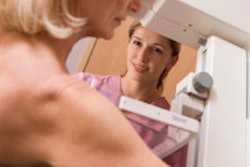Medicare costs for breast screening are being driven higher by new technologies such as digital mammography and computer-aided detection (CAD), which are being adopted in spite of limited data on their effectiveness, according to a study published on Monday in JAMA Internal Medicine.
The study found that Medicare spending exceeded $1 billion annually during the 2006-2007 research period, with regions that have adopted technologies such as full-field digital mammography seeing higher breast screening costs. What's more, nearly half of Medicare spending is for screening women ages 75 and older, for whom routine screening is not recommended under existing guidelines.
"There is insufficient evidence to assess the benefits and harms of screening mammography in this age group," wrote a research team led by Dr. Cary Gross, assistant professor of medicine at Yale University. "This reinforces the need to develop evidence to guide both clinical decision-making and coverage decisions."
More than $1B annually
Compared with treatment, relatively little is known about the costs associated with screening Medicare beneficiaries for breast cancer, according to the researchers. This is a timely question, considering the relatively recent introduction of technologies such as digital mammography and CAD, which are leading to increased costs. These costs are both direct, through these procedures themselves, and indirect, through follow-up tests that may be required (JAMA Internal Medicine, January 7, 2013).
The researchers used the 2006 and 2007 Surveillance, Epidemiology, and End Results (SEER) Medicare database to identify 137,274 women ages 66 to 100 who had no history of breast cancer as of December 31, 2005. They analyzed demographic trends of all women, data about the subgroup of women who had screening mammograms, and data about those who were diagnosed with breast cancer. They used hospital referral regions (HRRs) to examine geographic variations, including reimbursement rates for screening and subsequent treatment.
Forty-two percent of the women in the study were younger than age 75, and almost 60% of this group had one or more screening mammograms. Women ages 75 to 85 represented 40% of the total; 42% of this group had mammograms. Women 85 years and older represented 18% of the total; only 15% of this group had mammograms. Women with multiple chronic health conditions were much less likely to have a mammogram (26.6%) than healthy women (47.4%).
The cost of breast cancer screening and related workups for Medicare beneficiaries was $1.08 billion annually in 2006 and 2007, according to Gross and colleagues. Women 75 years and older accounted for $410 million annually.
The researchers identified wide variation in payments by geographic region in the Medicare fee-for-service schedule, from approximately $40 to $110 for a screening mammogram. The median was $63. Extrapolating the costs, they estimated that the annual cost to Medicare for breast cancer screening was $723.1 million, and the cost of workup of suspicious lesions was $359 million.
The group determined that women living in higher-cost regions were significantly more likely to undergo digital screening mammography. (During the time of the study, the market penetration of digital mammography systems in the U.S. was just starting to escalate.)
Digital screening mammography accounted for 47% of the difference in cost between women living in HRRs with the highest and lowest costs, while breast biopsy (21%) and CAD (18%) were also major contributors to differences in regional costs. Film-screen mammography (5%), diagnostic mammography (7%), or other imaging modalities (2%) were not significant cost contributors.
One particularly provocative discovery was that women living in regions with high screening costs were as much as 78% more likely to be diagnosed with early-stage or in situ breast cancer compared to women in lower-cost regions. At the same time, there was no difference in diagnosis of stage IV cancer; the authors speculated this could be evidence of "overdiagnosis" in the higher-cost regions.
"It was not the goal of our study to assess overdiagnosis," however, Gross told AuntMinnie.com. "Because we only had two-year outcome data, we were unable to reliably assess long-term outcomes in the different regions. In the context of other work by other investigators, our findings suggest that a more aggressive approach to testing may be identifying more early-stage cancers and may not actually be benefiting patients."
Future research is needed, he added: "Studies need to be performed to identify not only whether screening mammography is effective for older women, but to identify specific subgroups where benefits will outweigh harms and vice versa." Breast screening should continue to be covered by Medicare, he believes, because while there currently is no evidence to support the effectiveness of screening mammography in this age group, it does not mean there is evidence that it is not effective.
Value of digital mammography?
With screening costs incorporated, the costs of breast cancer care in Medicare are "substantially higher than previously documented," and the higher costs for digital technologies did not appear to be leading to lower treatment costs, the authors concluded. They noted that Medicare spending for screening may be growing faster due to policies that support the "rapid adoption of newer modalities, frequently without adequate data to support their use."
"As the field of radiology moves toward digital technology, it is important to note that digital mammography will frequently be the only option available," they wrote. "Our results suggest that the cost and effectiveness of such evolutions of technology should be promptly and rigorously evaluated; higher costs associated with the adoption of newer modalities may not necessarily yield superior outcomes."
"Let's get all the data we can before making a decision about putting new technologies into widespread use in the Medicare population," Gross told AuntMinnie.com. "If we don't know if a particular treatment or screening approach is effective in older patients, let's identify a fair and equitable approach to generate evidence, perhaps even simultaneous with a provisional coverage decision."
In an accompanying editorial, Dr. Jeanne Mandelblatt, from Georgetown University's Lombardi Comprehensive Cancer Center, and co-commentators suggest that "one logical consequence of the demographic and fiscal imperatives the United States and other countries are facing would be to examine how Medicare can be maintained but allow for more 'personalized,' evidence-based coverage to increase program efficiency, lower costs, and integrate different values."
While diagnosing and treating a breast cancer may not extend the life of an older woman, such treatment may allow her to have a better quality of life. "The real question raised by the research of Gross et al that must be answered is how we [as a society] put a value on the life of any person or group," they concluded.



















